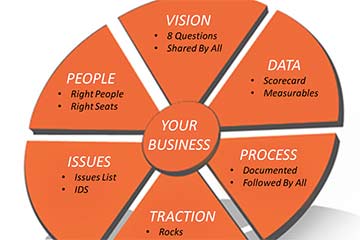Entrepreneur-lead businesses can become unwieldy as they grow. To survive, founders often must embrace a management system and delegate responsibilities.
“An entrepreneur slips and falls off the edge of a cliff. On his way down, he manages to grab onto the end of a vine. He’s hanging there, a thousand feet from the top and a thousand feet from the bottom,” wrote Gino Wickman in his book, “Traction: Get a Grip on Your Business.”
“His situation seems hopeless, so he looks up to the clouds and decides, for the first time, to pray. ‘Is anybody up there?’ he asks. After a long silence, a deep voice bellows down from the clouds, ‘Do you believe?’ ‘Yes,’ replies the entrepreneur. ‘Then let go of the vine,’ says the voice. The entrepreneur pauses for a second, looks up again, and finally responds, ‘Is anybody else up there?’”
Letting Go
Wickman’s point is that many businesses fail to grow because their entrepreneurial leaders are unwilling to let go. These over-involved leaders may have a hand in everything from developing products to responding to customers or even packing orders during peak selling periods.
Passionate and engaged, these individuals might work long hours, and their work might be paying off. The company could be growing. But with each new growth milestone, the burden becomes heavier, and the entrepreneur must work even more. It’s an unsustainable model.
In this way, letting go of the vine might represent building a leadership team to take on some or even most of the entrepreneur’s responsibilities. This delegation elevates both the entrepreneur and the business.
But having a good or even great leadership team may not be enough. The entrepreneur will also need a management system she can believe in. This founder needs to have faith, if you will, before letting go.
Management Systems
The good news is that established management systems can help entrepreneurial ecommerce businesses run extremely well.
Wickman’s system, for example, is called EOS — entrepreneurial operating system. The idea is that, like a computer, every business has an operating system. So, why not have an organized, named approach to setting a business’s goals and developing the various areas of the company? EOS has six areas of focus: people, vision, data, issues, process, and traction.

The EOS model focuses on six aspects to help companies become organized and growth-oriented: people, vision, data, issues, process, and traction.
Similarly, Verne Harnish’s Scaling Up business management system has helped many entrepreneurial companies achieve exceptional results. One of the best-known examples is Atlassian, an Australian software company that owns Jira and Trello (respectively, software-development and collaboration tools). The business started in 2002 and adopted Harnish’s system. In 2015, Atlassian went public with an initial market capitalization of around $4 billion.
Now, some five years later, Atlassian’s market cap is around $48.7 billion.
The point is that EOS, Scaling Up, and similar approaches provide a structure that a founder can trust. They provide a level of insight and control that makes letting go feel safe and appropriate.
The Pandemic
Sometimes it is easiest to accept change in the midst of turmoil, such as the global pandemic.
The status quo has been tossed out the window for most businesses. Some ecommerce companies have enjoyed an explosion of sales, forcing them to invest rapidly in inventory, systems, and even warehouse space.
Others have experienced unprecedented supply chain challenges and changing shopper behavior. Traditional brick-and-mortar retailers have suddenly invested millions in ecommerce.
Some companies that had on-premises staff — purchasing, finance, marketing — had to pivot toward a remote workforce. And now, several months on, many of those remote workers have no intention of returning to an office, ever.
The pandemic, in this sense, is an obstacle and a change agent. It’s an opportunity for entrepreneurs to invigorate their companies with new frameworks, such as EOS or Scaling Up, and to develop a broader objective for the enterprise — the Hedgehog Concept that Jim Collins describes in his book, “Good to Great,” or Wickman’s vision component in EOS.




